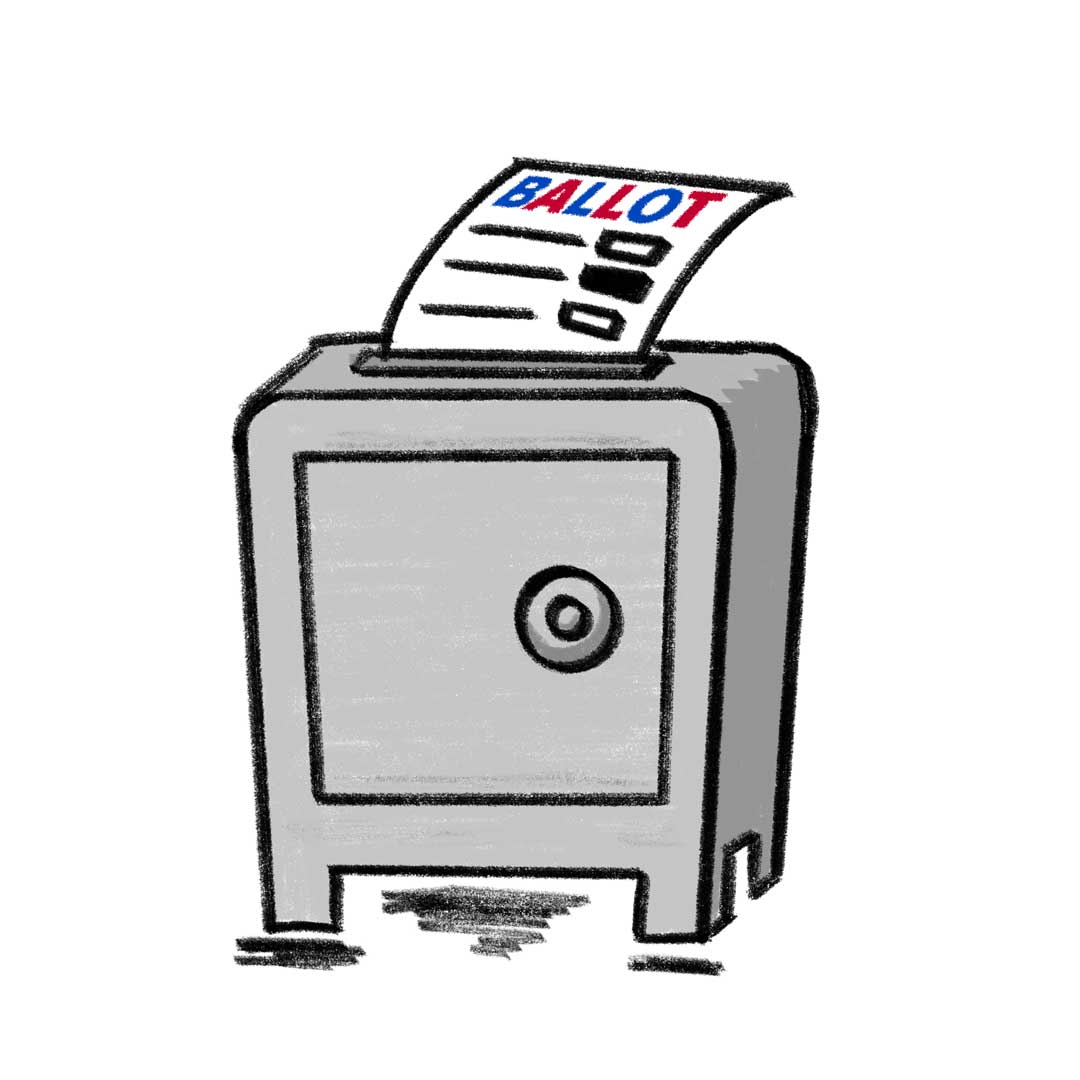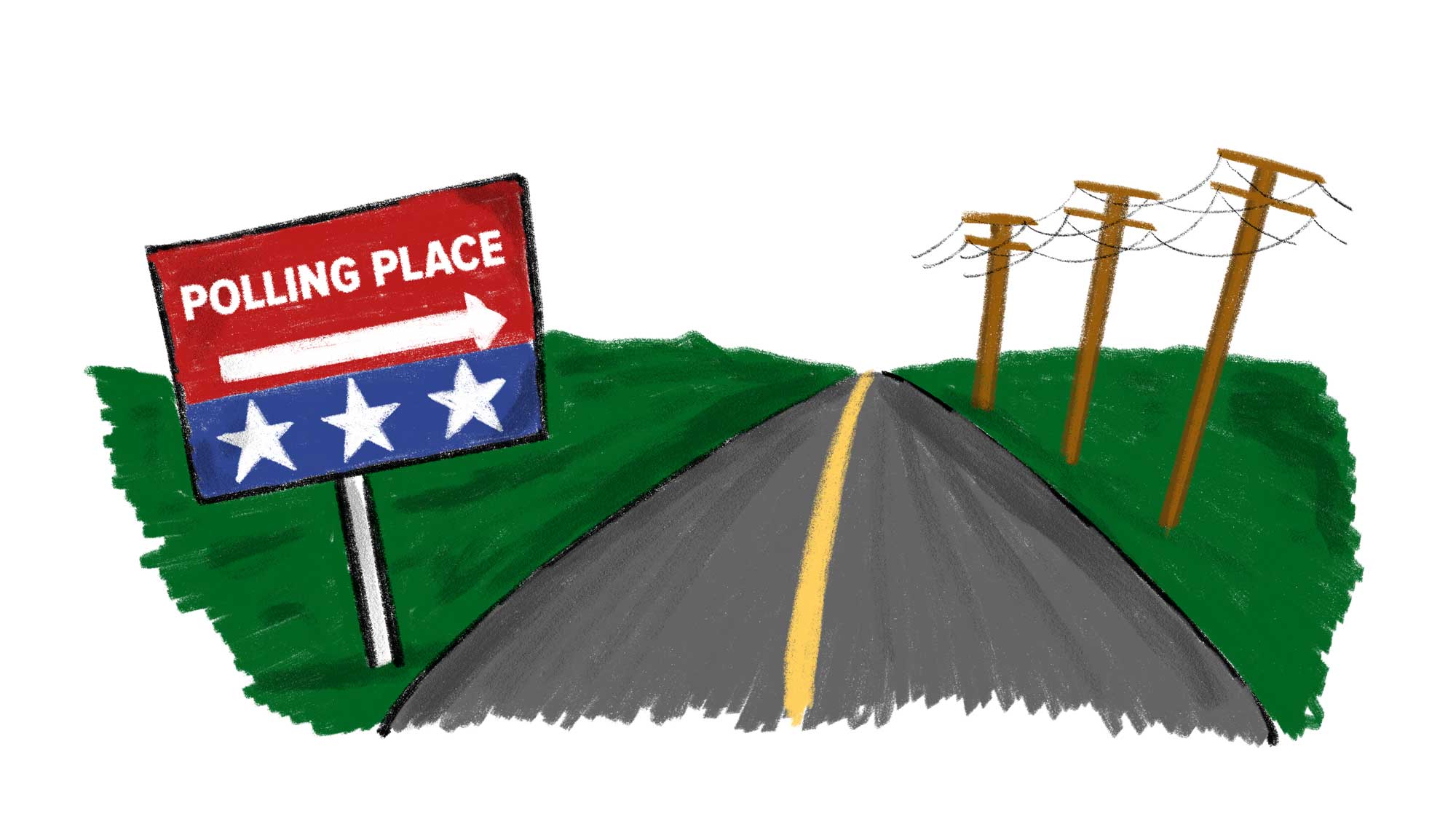As the presidential election heats up, a vast array of issues takes center stage. UC Davis Magazine went to experts in political science, economics, law and more for insights on what’s happening now and what’s at stake. Here, they answer some crucial questions for 2024.
Do Mass Media Really Matter for Elections?
By Amber Boydstun, professor of political science
It’s not a rhetorical question. After all, elections historically hinge mostly on economic conditions, with influential campaign media moments being the exception to the norm. Plus, more than 40% of Americans surveyed in 2024 say they are not following news about the election closely, suggesting that any media election coverage wouldn’t reach them directly. And in the current splintered media environment, isn’t everyone getting a different media message anyway?
But in fact, mass media — spanning from print newspapers to social media and everything in between — matter a lot. Because even though many people aren’t tracking news about the election, they’re still getting the news secondhand. And although the media landscape is indeed splintered, when it comes to political news, mass media tend to cover the same basic events at the same time, even if the spin is different.

Take, for example, the 2023 video of Vice President Kamala Harris quoting her mother as saying, “You think you just fell out of a coconut tree? You exist in the context of all in which you live and what came before you.” This video clip went viral on social media, but also was picked up and explained (perhaps mostly for older readers who don’t follow social media) by traditional news outlets across the country. And the coconut meme coverage has been only a fraction of the surge in mainstream media coverage about Harris, most of it positive. It is perhaps no coincidence that Americans’ positive perceptions of Harris have surged in tandem, with the percentage of Americans having a favorable opinion of Harris jumping nearly 10 points since President Biden stepped out of the race and Harris’ coconut quote became a meme. As of mid-August, Harris is polling ahead of former President Trump in key swing states.
The tale of Harris’ lightning-fast ascension to the Democratic nominee underscores another facet of how mass media matter: Media coverage sets the tempo for what Americans are focusing on. Consider that it was barely a month ago that former President Trump survived an assassination attempt. Yet media attention has lurched — as it always does — to the next exciting thing, with Harris’ campaign now overshadowing Trump’s in media coverage and in donations, at least for the moment.
And lest we think the power of mass media in the 2024 election resides solely with social media, consider how we got to a Harris vs. Trump election in the first place. It was a presidential debate on old-school television that initiated President Biden’s decision to hand his mantle to Harris. Barely 50 million viewers tuned in (down by 30 percent from Biden and Trump’s first debate in 2020). But even for people who didn’t watch the debate, it would have been impossible not to hear about it.
Because election news can turn on a dime, it’s way too early to predict whether these examples will make the top 10 reasons to pay attention to the power of mass media in an election year. But if 2024 has shown us anything, it’s that mass media matter, from the OG media of traditional journalism to the brat-green memes of TikTok.
What Is the Potential Impact on the Supreme Court?
By Vikram Amar, distinguished professor of law
Much is potentially at stake in the 2024 federal election concerning the Supreme Court.
For starters, while perhaps none of the current nine justices is actuarially likely to die within four-plus years, many are of an age when mental or physical disability could occur quickly and force retirement, giving the next president and the next Senate one or more court vacancies.
Putting aside involuntary departures, note that, by the end of the next presidential term in 2029, Justice Clarence Thomas will be 80 years old, Justice Samuel Alito 78, and Justice Sonia Sotomayor 74, making it very possible (perhaps likely) that one or more of these justices would voluntarily step down before 2029 if there were a president and a Senate of his or her preferred party. Recall that Justice Breyer voluntarily stepped down seemingly to give his seat to President Barrack Obama and the Democrats, and Justice Anthony Kennedy did the same thing for the Republicans during Donald Trump’s presidency. (Recall also that many Democrats lament that Ruth Bader Ginsburg did not step down to give her seat to President Obama.)
Of course replacing conservative justices with conservative justices (as Donald Trump would be expected to do) or replacing a liberal justice with a liberal justice (as Kamala Harris would be likely to do) wouldn’t alter the ideological balance of the court in the short run, but it could affect the court’s ideology in the longer term. For example, if Justices Thomas and Alito were replaced with younger, equally conservative justices, then the court’s current six-person conservative majority would be expected to endure for a couple more decades at least, regardless of election results in 2028, 2032, 2036 and 2040.
In addition to these possible effects on court makeup, the reforms (e.g., term limits for justices, a mandatory ethical code with external enforcement, etc.) that many Democrats (and some Republicans) favor would be more or less likely ever to be enacted depending on who wins the White House and Congress.
One final point: The Supreme Court sits atop a pyramid of lower federal courts, whose makeup is very important to the nation’s administration of law and whose ideological identity could be greatly affected by the upcoming election, given the large number of lower court retirements and vacancies that are sure to occur.
What Are Elections’ Effects on Consumers?
By Derek Stimel, associate professor of teaching economics
Elections affect consumers because elections affect the expected future path of economic policy. As policymakers, newly elected officials may enact changes to taxes, government spending, or the rules and regulations that businesses and consumers operate under. One view is that consumers desire to “smooth” consumption; that is, they try to avoid large swings up or down in their consumption relative to their expected long-term average income, referred to as “permanent” income. For example the impact of a tax change depends on whether it is perceived as temporary or permanent by consumers. If perceived as temporary a consumer may offset it by saving more or less in order to maintain consumption; if perceived as permanent they may ultimately change their consumption level to match their new status quo. Changes in spending priorities for the government can also affect consumers because dollars spent domestically become income for someone, affecting their ability to consume. Similarly changes to regulations may affect consumer choices about their spending as well.
Consumers may struggle to assess how economic policy changes arising from election results will ultimately affect their income and consumption decisions. Economic policy is a complicated and opaque mix of many different taxes, areas and mechanisms of government spending, and voluminous amounts of rules and regulations. There may be effects not just on income, but wealth, and other relevant factors like interest rates, inflation, and labor market conditions to name a few. Ultimately this can affect the sentiment of consumers, which is also thought to impact their spending decisions. One study found evidence that counties predisposed to vote for the losing party in a national election become more pessimistic about economic policy post-election. However, that study found they didn’t change their consumption very much. Perhaps this shows consumers view election results as temporary changes rather than permanent as the next election is always on the horizon.
With Trump Being the Oldest Presidential Candidate, What Do We Know About His Cognition?
By Charan Ranganath, professor of psychology
We should be cautious about overgeneralizing. We know that the ability to remember recent events, or “episodic memory,” gets worse on average as we get older. The decline starts in the 30s actually. But when you follow individuals, you see that the trajectories vary a lot — some “super agers" remain solid into old age, and others decline precipitously. Also, the cause of the deficit matters — in many cases, we can’t find the memories we are looking for because of changes in the functions of the prefrontal cortex, a brain area that is highly affected by healthy aging. Some people have dysfunction of the hippocampus, a brain area that is critical for forming memories in the first place, and that is often an early indicator of diseases like Alzheimer’s.
Older people are also vulnerable to external factors that affect memory, like sleep deprivation, physical and mental illness, and medication side effects. These are factors that can make someone appear to be demented and non-functional at some moments and perfectly lucid and high functioning at others.
Keep in mind that some aspects of memory don’t change much (or even improve) with age, like knowledge of relevant facts (semantic memory). We should also note that, even in the absence of dementia, there are many non-memory factors that can be important for the functioning of an elected official, some of which decline with age — like the ability to pay attention and stay on task or to quickly solve complex problems — and others which typically do not (emotional stability, compassion, morality).
Finally, I hear a lot from people that they can judge a candidate’s mental status because, “I know what I see.” That isn’t necessarily true. People notice physical dexterity, verbal fluency, and attention deficits pretty quickly, but unless you know someone or do a thorough work up, you would not know that they have a memory problem. So, I think people need to ask whether a candidate’s track record indicates competence, and whether the factors they see truly indicate an inability to do the job (as opposed to something like grey hair or a slow gait that triggers stereotypes about aging).

How Do We Secure our Elections?
By Matt Bishop, professor of computer science
Secure elections depend upon election officials running the elections, the voting mechanisms used to record, count, and report totals, and the voters themselves, who cast the votes. Each state runs its part of the national election, and the results are combined to form the national popular and electoral votes. While all states follow broad principles, the details of how these principles are implemented among states vary.
The requirement of anonymity requires that no one, not even the voter, be able to prove how they voted. This makes auditing elections (which every jurisdiction does) difficult because one cannot contact a voter to verify their votes are recorded and cast as intended. So audits check that the systems counting the ballots did so correctly. With paper ballots or, for electronic systems, "Voter-Verified Paper Audit Trails," the validation can be done manually: Select a set of ballots as required by state law, count them, and check that the result matches the recorded totals. Otherwise, one must must trust the voting systems to accurately recount the selected set of ballots.
The COVID pandemic led to the widespread adoption of mail-in voting. That has the advantage of forcing voters to mark their ballots as they intend, and physically mail the paper ballot to Election Central or hand-deliver the ballot to a voting center or polling station. The election officials check the signature on the envelope, then remove the ballot and count it. The main problem is someone being forced to vote a certain way, rather than the way they want to. At a voting center, the voter votes privately, so coercion is much harder. Except for that, the votes are as secure as the U.S. Mail (or voting centers) are.
The audit, and checking of the signatures, are examples of steps that make the entire election process as foolproof as possible. The key is the individual voter; if you do not vote, that guarantees your vote will not be counted!

What Is Important to Rural Voters?
By Lisa Pruitt, distinguished professor of law
The selection of Tim Walz as Democratic nominee for vice president and J.D. Vance as Republican nominee for that office has led to a recent resurgence of interest in the rural vote. Each of these men — different as they are in disposition and policy positions — is a potential avatar for rural voters.
Rural voters were, of course, largely blamed (or credited, depending on your perspective) for the election of Trump in 2016. That is a misunderstanding in the sense that rural voters have nowhere near the electoral heft to deliver a presidential win.
Still, Trump enjoyed a two-to-one advantage among rural voters in 2016, and he further consolidated the rural vote in 2020, suggesting that the rural-urban divide has “replaced the North-South axis as the nation’s biggest source of political friction.”
The association of Trump with rural voters has caused many progressives to write off these voters as illiberal and intolerant, even racist and misogynist. But a rigorously researched book, The Rural Voter, published in 2023, reveals these voters’ attitudes toward a wide range of cultural issues to be statistically indistinguishable from urban and suburban voters.
A significant factor in this shift is little acknowledged — and perhaps little known: Democratic Party organizations at the national and state levels have neglected rural voters. Senate minority leader Chuck Schumer summed up the thinking of much of the party’s leadership in 2016 when he commented, “For every blue-collar Democrat we lose in western Pennsylvania, we will pick up two moderate Republicans in the suburbs in Philadelphia.” That was in the summer of 2016, and the senator was soon proved wrong, as Hillary Clinton lost the critical swing state of Pennsylvania. A few party leaders have since worked hard to reverse course and channel resources to local rural candidates and local party organizations, but any course correction will take time.
Another misunderstanding arises from the conflation of rural voters with red-state voters. In fact, many rural voters live in “blue states,” including in California, where the Central Valley and far north lean Republican. Meanwhile many progressive voters live in “red states” — think Boise in the context of wider Idaho.
Nevertheless, the disproportionate power that low-population states have in both the U.S. Senate and the Electoral College has driven urban resentment of “rural voter.” This has dramatically aggravated political polarization along the rural-urban axis. In fact, a far more consequential feature of our electoral system is the winner-take-all system by which all states (except Maine and Nebraska) allocate their electoral votes. This disenfranchises rural voters in California just as it disenfranchises urban voters in states like Idaho. A related issue is the concentration of campaign resources on close elections — on “battleground states” and away from states like California.